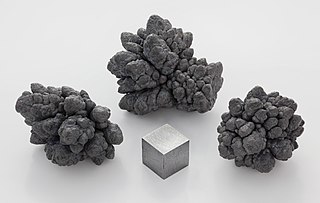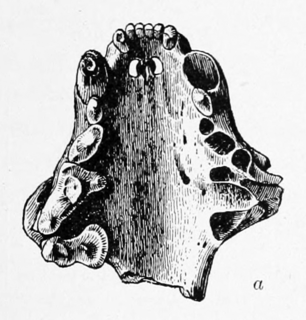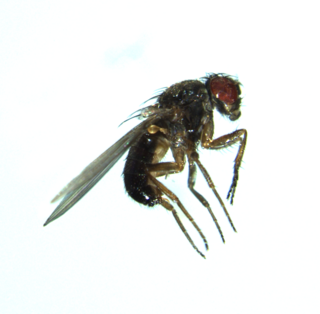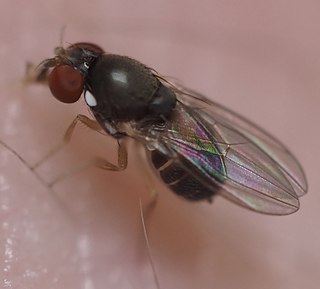Related Research Articles

Drosophila is a genus of flies, belonging to the family Drosophilidae, whose members are often called "small fruit flies" or pomace flies, vinegar flies, or wine flies, a reference to the characteristic of many species to linger around overripe or rotting fruit. They should not be confused with the Tephritidae, a related family, which are also called fruit flies ; tephritids feed primarily on unripe or ripe fruit, with many species being regarded as destructive agricultural pests, especially the Mediterranean fruit fly.

Lead is a chemical element with the symbol Pb and atomic number 82. It is a heavy metal that is denser than most common materials. Lead is soft and malleable, and also has a relatively low melting point. When freshly cut, lead is silvery with a hint of blue; it tarnishes to a dull gray color when exposed to air. Lead has the highest atomic number of any stable element and three of its isotopes are endpoints of major nuclear decay chains of heavier elements.

The sea mink is a recently extinct species of mink that lived on the eastern coast of North America around the Gulf of Maine on the New England seaboard. It was most closely related to the American mink, with continuing debate about whether or not the sea mink should be considered a subspecies of the American mink or a species of its own. The main justification for a separate species designation is the size difference between the two minks, but other distinctions have been made, such as its redder fur. The only known remains are bone fragments unearthed in Native American shell middens. Its actual size is speculative, based largely on tooth remains.

The Drosophilidae are a diverse, cosmopolitan family of flies, which includes species called fruit flies, although they are more accurately referred to as vinegar or pomace flies. Another distantly related family of flies, Tephritidae, are true fruit flies because they are frugivorous, and include apple maggot flies and many pests. The best known species of the Drosophilidae is Drosophila melanogaster, within the genus Drosophila, also called the "fruit fly." Drosophila melanogaster is used extensively for studies concerning genetics, development, physiology, ecology and behaviour. Many fundamental biological mechanisms were discovered first in D. melanogaster. The fruit fly is mostly composed of post-mitotic cells, has a very short lifespan, and shows gradual aging. As in other species, temperature influences the life history of the animal. Several genes have been identified that can be manipulated to extend the lifespan of these insects. Additionally, Drosophila subobscura, also within the genus Drosophila, has been reputed as a model organism for evolutionary-biological studies, along with D. sechellia for the evolution of host specialization on the toxic noni fruit and Scaptomyza flava for the evolution of herbivory and specialist on toxic mustard leaves.

"Porque te vas" —often but mistakenly referred to as "¿Por qué te vas?" or "Porqué te vas" —is a song by English-born Spanish singer Jeanette, written by José Luis Perales and produced by Rafael Trabucchelli for record label Hispavox in 1974.
The following is a list of players, both past and current, who appeared in at least one game for the Cleveland American League franchise known as the Blues (1901), Bronchos (1902), Naps (1903–14), Indians (1915–2021), and Guardians (2022–present).

The Drosophila obscura species group belongs to the subgenus Sophophora and contains 6 subgroups: affinis, microlabis, obscura, pseudoobscura, subobscura, and sinobscura.

Hirtodrosophila is a genus of fruit flies from the family Drosophilidae. Originally Hirtodrosophila was a subgenus of the genus Drosophila. It was raised to the status of genus by Grimaldi in 1990.

The genus Zaprionus belongs to the family fruit fly Drosophilidae and is positioned within the paraphyletic genus Drosophila. All species are easily recognized by the white longitudinal stripes across the head and thorax. The genus is subdivided in two subgenera, based on the presence of an even or odd number of white stripes. The species of the genus can be found in Africa and Southern Asia. One species, Zaprionus indianus, has invaded the New World.

Hydrophorinae is a subfamily of flies in the family Dolichopodidae. According to Germann et al. (2011), the subfamily is polyphyletic.

Drosophila subobscura is a species of fruit fly in the family Drosophilidae. Originally found around the Mediterranean, it has spread to most of Europe and the Near East. It has been introduced into the west coasts of Canada, the United States, and Chile. Its closest relative is Drosophila madeirensis, found in the Madeira Islands, followed by D. guanche, found in the Canary Islands. These three species form the D. subobscura species subgroup. When they mate, males and females perform an elaborate courtship dance, in which the female can either turn away to end the mating ritual, or stick out her proboscis in response to the male's, allowing copulation to proceed. D. subobscura has been regarded as a model organism for its use in evolutionary-biological studies.

Chymomyza is a genus of vinegar flies.
Microdrosophila is a genus of vinegar flies, insects in the family Drosophilidae. There are at least 70 described species in Microdrosophila.

Lordiphosa is a genus of fly in the family Drosophilidae.

Amiota is a genus of flies belonging to the family Drosophilidae. The genus has a cosmopolitan distribution.
References
- ↑ Bächli, Gerhard (20 January 2022). "The database on Taxonomy of Drosophilidae". TaxoDros.
- ↑ O’Grady, Patrick M.; DeSalle, Rob (1 May 2018). "Phylogeny of the Genus Drosophila". Genetics. 209 (1): 1–25. doi:10.1534/genetics.117.300583.
- ↑ Patterson, Colin (1999). Evolution. Cornell University Press. ISBN 0-8014-8594-0.
- ↑ Sturtevant, A. H. (1939). On the subdivision of the genus Drosophila. Proceedings of the National Academy of Sciences of the United States of America 25, 137–141.